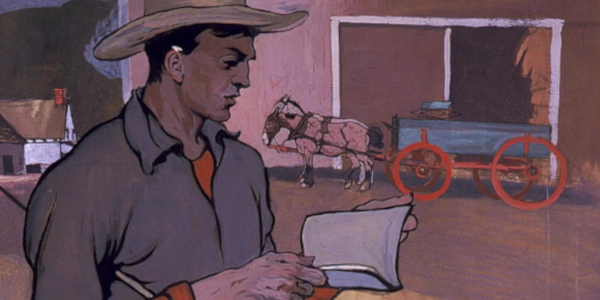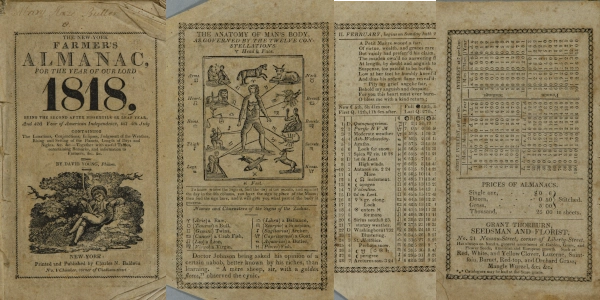Sponsor this page. Your banner or text ad can fill the space above.
Click here to Sponsor the page and how to reserve your ad.
- Timeline
1818 - Detail
January 1, 1818 - The first edition of the Farmer's Almanac is published in Morristown, New Jersey.

It was the brainchild of David Young, a poet, astronomer, and teacher, plus Jacob Mann, who would publish it, although the name of the publisher on the first issue states Charles N. Baldwin. The Almanac Publishing Company would publish this yearly edition with long-range weather forecasts, fun facts, and advice on farming, gardening, fishing, and soil conservation. Young was an aloof and eccentric man, born in 1781, therefore about thirty-seven when he had the idea of a publication which could appeal to and help farmers. He was kind, absentminded, and married. David Young was well-respected for his astronomical skills, once hired by the French to prove whether there was an eclipse on the date of Jesus' crucifiction; Young said not.
Jacob Mann was a printer from Morristown, New Jersey. The original edition, 1818, had thirty-six pages covering the twelve months of 1818. Although it likely went on sale prior to the January 1, 1818 listed above, we are using that date as it was the first forecast. In subsequent editions, the Farmers' Almanac included forecasts sixteen months in advance, and is now published in August of the previous year and broken into seven zones in the United States. They are then broken into three day intervals.
How do they do their predictions? Of course, it's proprietary, but utilizes sunspots, tidal action, astrology and planet positions, plus other items they won't divulge. Almanac followers state that it has an 80-85% accuracy rate. Scientists claim it is much lower.
And what were the topics covered in the first edition in 1818? Page one (see below) shows the image of a young boy, and statement that it contains "The Lunations, Conjunctions, Eclipses, Judgment of the Weather, Rising and Setting of the Planets, Length of Days and Nights, &c. &c. - Together with useful Tables, entertaining Remarks, and information to
farmers, &c. &c." Page 2 shows the anatomy of a man's body according to the constellations. There were poems ...
"A Petit Maitre wooed a fair,
Of virtue, wealth, and graces rare;
But vainly had preferr'd his claim,
The maiden own'd no answering flame
At length, by doubt and anguish torn,
Suspense, too painful to be borne,
Low at her feet he humbly kneel'd,
And thus his ardent flame reveal'd:
" Pity my grief angelic fair,
Behold my anguish and despair;'
For you this heart must ever burn-
O bless me with a kind return;
Other pages included tips on how to raise cattle, conserve and repair exhausted ground, advertisements, high water marks at various cities, a table or roads, rates of postage, and more.
Of virtue, wealth, and graces rare;
But vainly had preferr'd his claim,
The maiden own'd no answering flame
At length, by doubt and anguish torn,
Suspense, too painful to be borne,
Low at her feet he humbly kneel'd,
And thus his ardent flame reveal'd:
" Pity my grief angelic fair,
Behold my anguish and despair;'
For you this heart must ever burn-
O bless me with a kind return;
Farmers Almanac History
By the time the National Weather Service was founded, the Farmers' Almanac had already published fifty-two years of long-range weather forecasts. Circulation of the Almanac took a huge jump during the tenure of its sixth editor, Ray Geiger. From 1933 when he started editing the magazine, his huge personality and enthusiasm for the job even allowed him to publish during World War II when he was stationed in the Pacific theater.
After the war was over, Geiger and his wife purchased the publication and publishing company. When the age of television began, Geiger became one of the most interviewed men in the nation, promoting the Farmers' Almanac on shows such as Art Linkletter, David Letterman, and others. During that period, the company moved to Lewiston, Maine, and the circulation grew from eighty-five thousand copies to more than six million per year.
The publication still survives through today, with Ray Geiger's son, Peter, as co-editor with Sandi Duncan. It has both an online and retail publication. There is another publication with a similar name, the Old Farmers Almanac, which had been published since 1792. Yes, during the days of George Washington. It was originally published by David Robinson, and is the oldest continuously published publication in the United States to this day. During its first year, the circulation was three thousand copies. In 1863, its circulation was 225,000.

Image above: Painting showing a Farmer Consulting Farmers' Almanac, 1884/1925, Edward Penfield. It was an advertisement for Studebaker Automobiles. Courtesy Library of Congress. Image below: Four pages of the first edition, including (left) the front cover, and (right) the back cover, 1818, Farmers' Alamanac (PDF Copy). Source Info: Farmersalmanac.com; Library of Congress; National Library of Medicine; Wikipedia Commons.





